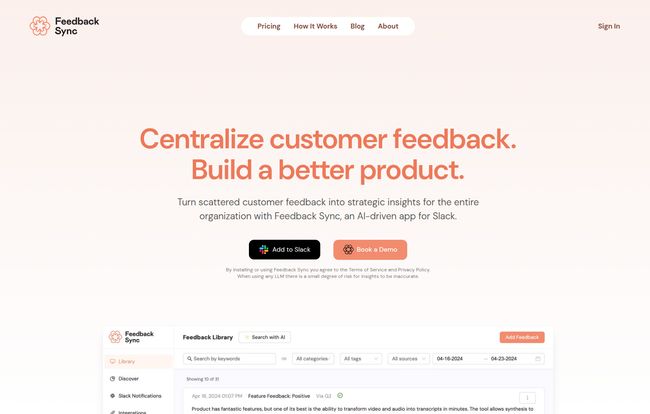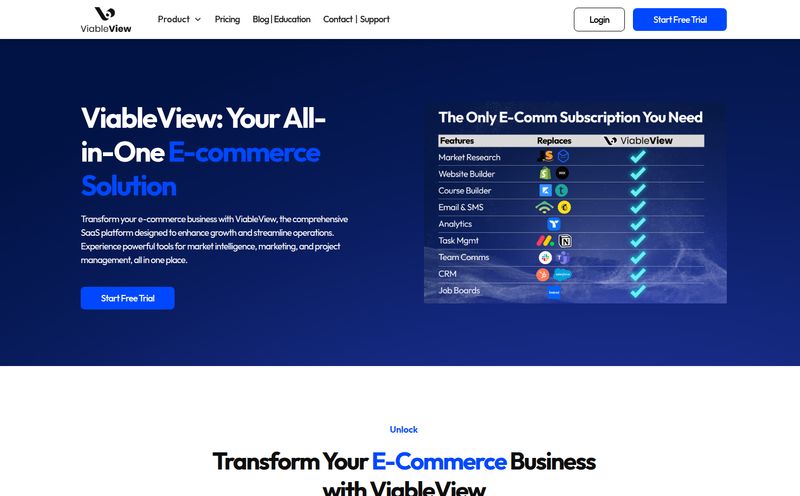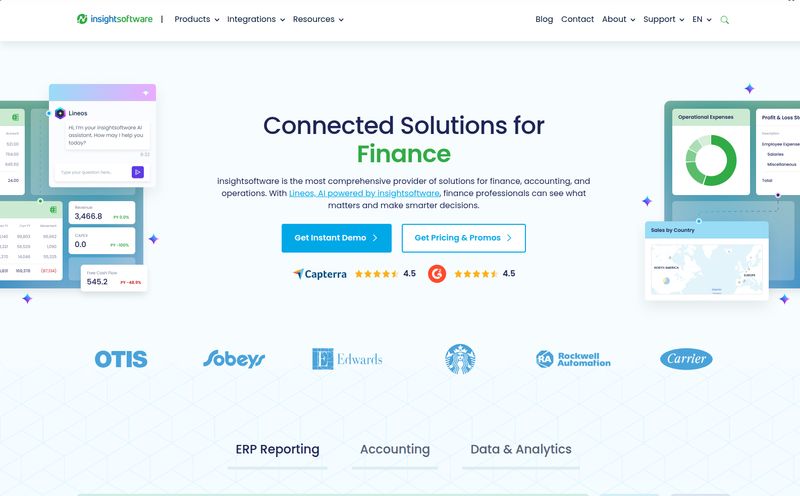If you're a product manager, a founder, or even in customer success, your life is probably governed by a chaotic symphony of feedback. It’s coming at you from every direction—a Slack message here, a Zendesk ticket there, a G2 review over yonder, and maybe even a carrier pigeon if you've been in the game long enough. I remember the days of sprawling spreadsheets and walls covered in sticky notes, trying to connect dots that were scattered across ten different apps. It’s like trying to solve a puzzle when half the pieces are hidden under the sofa.
For years, we've just accepted this as the cost of being 'customer-centric'. But what if it didn't have to be? I've seen a lot of tools promise to be the silver bullet for this problem, and frankly, most of them just create another silo. So when I came across Feedback Sync, an AI-driven Slack app, my seasoned skepticism was on high alert. But, I have to admit, my curiosity was piqued. An app that promises to centralize everything and give you strategic insights? In Slack? Okay, you have my attention.
So What Exactly Is Feedback Sync?
At its core, Feedback Sync is an AI-powered brain that plugs directly into your company’s central nervous system: Slack. Its mission is simple but ambitious: to take all that scattered customer feedback from different sources and turn it into a single, organized, and—most importantly—actionable library of insights. It’s designed to drastically shorten the feedback loop. You know, that sacred cycle of listening to users, understanding their problems, and shipping better products faster. In today's world of product-led growth, whoever has the shortest loop, wins.
It does this by integrating directly with the tools you're already using. We're talking about the heavy hitters: Slack, G2.com, Zendesk, and Jira. It automatically pulls in feedback, so you can stop the soul-crushing copy-paste routine.

Visit Feedback Sync
Finally, an End to Manually Sifting Through Feedback
The homepage of Feedback Sync has this line that just gets it: "Manually sifting through feedback?" It's a question that every PM has sighed at. The tool's whole philosophy seems to be built around the idea of "Set it. Forget it." You connect your sources, and the app does the heavy lifting, automatically ingesting and analyzing new feedback as it arrives. This isn't just a time-saver; it’s a sanity-saver.
Think about it. Customer feedback is a river, not a pond. It flows constantly. Trying to manually categorize it is like trying to bottle that river with a thimble. Feedback Sync acts more like a sophisticated dam and filtration system, automatically sorting the water and highlighting what's most important so you can focus on building, not data entry.
The Features That Actually Matter
A tool is only as good as its features, right? But I’m not interested in a laundry list. I want to know what actually moves the needle. Here’s what stood out to me.
A True Centralized Feedback Library
This is the foundation. Having one single source of truth for all customer feedback is the dream. No more asking, "Wait, where did you see that comment?" or losing a brilliant suggestion in a forgotten Slack thread. It’s all here, searchable and organized. This alone could probably justify the tool for many teams. It creates a collective memory for the entire organization.
Seriously Smart AI Search and Analysis
Okay, this is the magic. It's not just a dumb repository. Feedback Sync uses AI to find trends and summarize what users are talking about. The most compelling part for me? It delivers weekly summaries directly in Slack. Imagine starting your Monday with a clear, concise report on the top user requests, pain points, and praises from the last week. That’s not just data; that’s a strategic advantage, handed to you on a silver platter. It helps you see the forest for the trees, something thats almost impossible when you're in the weeds every day.
Integrations That Fit Your Existing Workflow
I can’t stress this enough. A new tool that forces your team to change their entire workflow is often dead on arrival. Feedback Sync gets this. By integrating with Slack, Jira, Zendesk, and G2, it meets your team where they are. A product manager can see a trend in the weekly summary, find the related feedback, and push a new issue to the Jira backlog, all without leaving Slack. That's a workflow, not a work-around.
Let's Talk About the Pricing
Alright, the all-important question: what's this going to cost? I did have to click over to their pricing page to get the details, but the structure is pretty straightforward and, in my opinion, very well thought out. Here's how it breaks down:
| Plan | Price | Who It's For |
|---|---|---|
| Starter Plan | $0 | Perfect for small teams or solo PMs wanting to test the waters. You get 100 AI searches a month and up to 3 team members. It’s a genuine free tier to prove the value. |
| Business Plan | $149/month | This seems like the sweet spot for most growing companies. You get unlimited AI searches, up to 25 team members, and advanced reporting. This is for teams getting serious about feedback. |
| Enterprise Plan | Starting at $499/month | This is for the big leagues. Unlimited users, SSO, dedicated support, and custom integrations. It’s built for large organizations where security and scale are paramount. |
The free Starter Plan is a fantastic move. It lets you kick the tires and see if it works for your team without any commitment. I always appreciate a company that's confident enough to let their product speak for itself.
The Good, The Bad, and The AI
No tool is perfect. As an SEO and traffic guy, I know that better than anyone. So let's get real. The biggest win, for me, is the sheer efficiency. Automating the collection and initial analysis of feedback could easily save a product team 5-10 hours a week. That’s time spent on strategy, not spreadsheets.
Now for the potential hiccup. The platform relies on Large Language Models (LLMs) for its insights. And as we all know, AI can occasionally get things wrong or miss the nuance of a sarcastic comment. There is a small risk of getting an inaccurate insight. But let's be fair—this is a risk with any AI tool on the market today. I'd argue the value of having 95% of your feedback analyzed automatically far outweighs the small chance of one or two comments being misinterpreted. A human still needs to be in the loop, but this tool gets you most of the way there.
Who Should Be Using Feedback Sync?
This isn't a tool for everyone, but for certain roles, it feels like a godsend.
- The Overwhelmed Product Manager: This is your primary audience. If you're currently managing feedback with a clunky spreadsheet and a prayer, this tool is built for you.
- The Data-Driven Founder: For early-stage companies, understanding user needs is everything. This provides a direct line to your users' brains, helping you find product-market fit faster.
- The Proactive Customer Success Team: Instead of just reacting to problems, CS teams can use Feedback Sync to spot trends in user issues and feed them directly to the product team, preventing future tickets.
Frequently Asked Questions About Feedback Sync
How difficult is the setup process?
Based on the integration-first approach, it seems designed for a quick setup. You connect your existing tools like Slack and Zendesk, and the app starts ingesting data. It's meant to fit into your workflow, not overhaul it.
Is this tool useful if my company doesn't use Slack?
Honestly, probably not. The core value proposition is deeply tied to providing insights and a feedback library directly within Slack. If your team lives in Microsoft Teams or another platform, this might not be the right fit.
Can I customize the AI analysis?
The website mentions the ability to use custom tags, which suggests a good degree of control. This would allow you to categorize feedback according to your own product areas or strategic initiatives, making the analysis more relevant.
Is there a free trial?
Even better! There’s a permanent free “Starter Plan” that lets you test the core functionality with some limitations. The paid Business Plan also offers a trial, so you can definitely try before you buy.
How is this better than a shared spreadsheet?
Automation, AI-powered trend analysis, and workflow integration. A spreadsheet is a passive repository you have to manually update and analyze. Feedback Sync is an active, intelligent system that brings the insights to you automatically.
What about the security of my customer data?
The Enterprise plan offers SSO (Single Sign-On) and SLA guarantees, which indicates a strong focus on security for larger clients. For any company, this is a crucial question to ask during a demo.
My Final Verdict: Is Feedback Sync Worth a Shot?
After digging in, my initial skepticism has turned into genuine optimism. Feedback Sync isn't trying to reinvent the wheel; it's just making the wheel work a hell of a lot better within the systems we already use. It addresses a very real, very painful problem for product-focused companies.
If your team uses Slack and you're feeling the pain of scattered, unmanageable customer feedback, giving Feedback Sync a try feels like a no-brainer. Start with the free plan, connect a source or two, and see what it uncovers. You might just find the key to your next big feature hiding in plain sight.



